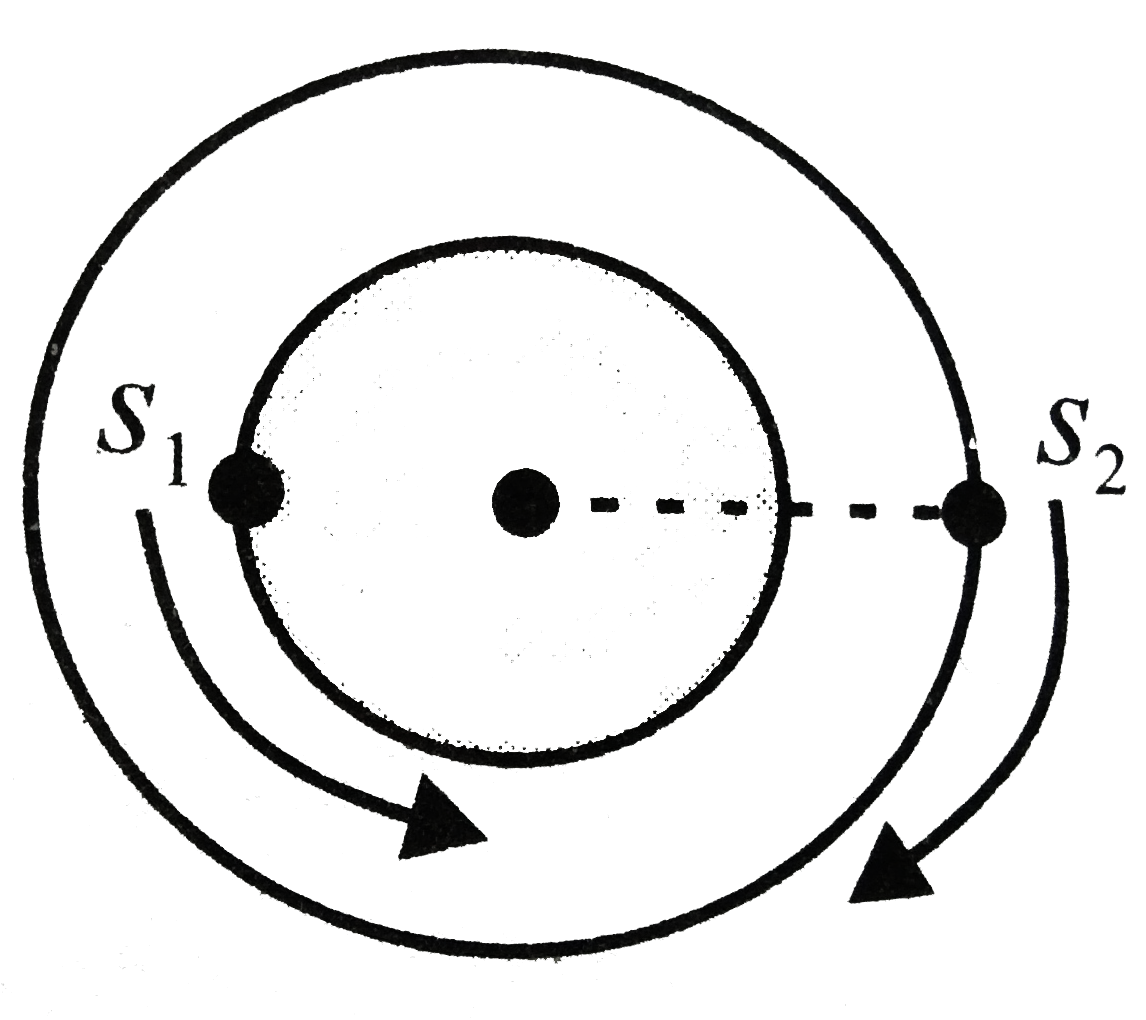Two satellites S1 and S2 revolve around a planet in coplanar circular orbits in the same sense their periods of revolution are 1 hour and 8hours respectively the radius of the orbit of S1 is 104 km when S1 is closest to S2 the angular speed of S2 as observed by an astronaut in S1 is :
π×104
−π×104
π×105
π×105
The correct Answer is:B
To solve the problem, we need to find the angular speed of satellite S2 as observed from satellite S1. Here’s a step-by-step breakdown of the solution:
Step 1: Identify the given data
- Period of satellite S1 (T1) = 1 hour = 3600 seconds
- Period of satellite S2 (T2) = 8 hours = 28800 seconds
- Radius of the orbit of S1 (R1) = 104 km = 107 m
Step 2: Use Kepler's Third Law to find the radius of S2
According to Kepler's Third Law:
T21T22=R31R32
Substituting the known values:
(3600)2(28800)2=(107)3R32
Calculating the left side:
12960000829440000=164
Thus, we have:
(107)3R32=164
This implies:
R32=64×(107)3
Taking the cube root:
R2=4×107 m
Step 3: Calculate the angular velocities of S1 and S2
The angular velocity (ω) is given by:
ω=2πT
For satellite S1:
ω1=2πT1=2π3600 rad/s
For satellite S2:
ω2=2πT2=2π28800 rad/s
Step 4: Calculate the angular speed of S2 as observed from S1
The angular speed of S2 as observed from S1 is given by:
ωobsS2=ω2−ω1
Substituting the values:
ωobsS2=2π28800−2π3600
Finding a common denominator (28800):
ωobsS2=2π28800−16π28800=−14π28800
Simplifying:
ωobsS2=−7π14400 rad/s
Conclusion
The angular speed of satellite S2 as observed from satellite S1 is:
ωobsS2=−7π14400 rad/s
- Period of satellite S1 (T1) = 1 hour = 3600 seconds
- Period of satellite S2 (T2) = 8 hours = 28800 seconds
- Radius of the orbit of S1 (R1) = 104 km = 107 m
According to Kepler's Third Law:
T21T22=R31R32
Substituting the known values:
(3600)2(28800)2=(107)3R32
Calculating the left side:
12960000829440000=164
Thus, we have:
(107)3R32=164
This implies:
R32=64×(107)3
Taking the cube root:
R2=4×107 m
The angular velocity (ω) is given by:
ω=2πT
For satellite S1:
ω1=2πT1=2π3600 rad/s
For satellite S2:
ω2=2πT2=2π28800 rad/s
The angular speed of S2 as observed from S1 is given by:
ωobsS2=ω2−ω1
Substituting the values:
ωobsS2=2π28800−2π3600
Finding a common denominator (28800):
ωobsS2=2π28800−16π28800=−14π28800
Simplifying:
ωobsS2=−7π14400 rad/s
The angular speed of satellite S2 as observed from satellite S1 is:
ωobsS2=−7π14400 rad/s
Topper's Solved these Questions
- BOOK - NCERT FINGERTPS ENGLISHCHAPTER - GRAVITATIONEXERCISE - NCERT Exemplear Problems.8videos
GRAVITATION
- BOOK - NCERT FINGERTPS ENGLISHCHAPTER - GRAVITATIONEXERCISE - Assertion & Reason Corner15videos
GRAVITATION
- BOOK - NCERT FINGERTPS ENGLISHCHAPTER - GRAVITATIONEXERCISE - Miscellaneous Question11videos
GRAVITATION
- BOOK - NCERT FINGERTPS ENGLISHCHAPTER - KINETIC THEORYEXERCISE - Assertion And Reason10videos
KINETIC THEORY
Similar Questions
Two satellites S1 and S2 revolve round a planet in coplaner circular orbit in the same sense. Their period of revolution are 1 hour and 8 hour respectively. The radius of the orbit of S1 is 104km. When S2 is closest to S1, find
(a) The speed of S2 relative to S1,
(b) The angular speed of S2 actually observed by an astronaut is S1View SolutionTwo satellite S1andS2 revolve round a planet in coplanar circular orbits in the same sense. Their periods of revolutions are 1 h nd 8 h respectively. The radius of the orbit of S1 is 104km. When S2 is closet to S1., find (a). The speed of S2 relative to S1 and (b). the angular speed of S2 as observed by an astronaut in S1.
View Solution
Knowledge Check
- Question 1 - Select One
In the above example the angular velocity of S2 as actually observed by an astronaut in S1 is -
A3×10−4B3×1023C3×10−6D3×10−7 - Question 2 - Select One or More
SN1 and SN2 reactions are
ABoth stereospecificBBoth stereoselectiveCStereoselective and stereospecific respectivelyDStereospecific and stereoselective respectively
SN1 is observed in
View SolutionTwo satellites S1 and S2 are revolving round a planet in coplanar and concentric circular orbit of radii R1 and R2 in te same direction respectively. Their respective periods of revolution are 1 hr and 8 hr. the radius of the orbit of satellite S1 is equal to 104km. Find the relative speed in kmph when they are closest.
View SolutionTwo satellites A and B revolve around a plant in two coplanar circular orbits in the same sense with radii 104km and 2×104km respectively. Time period of A is 28 hours. What is time period of another satellite?
View SolutionTwo satellities s1 a & s2 of equal masses revolves in the same sense around a heavy planet in coplaner circular orbit of radii R & 4R
View SolutionTwo satellites S1 and S2 are revolving around the earth in coplanar concentric orbits in the opposite sense. At t=0, the position of satellites are shown in the diagram. The periods of S1 and S2 are 4h and 24h, respectively. The radius of orbit of S1 is 1.28×104km. For this situation, mark the correct statement (s).
 View Solution
View SolutionTwo satellites S1 and S2 revolve around the earth at distances 3R and 6R from the centre of the earth. Find the ratio of their (a) linear speeds and (b) angular speeds.
View Solution

